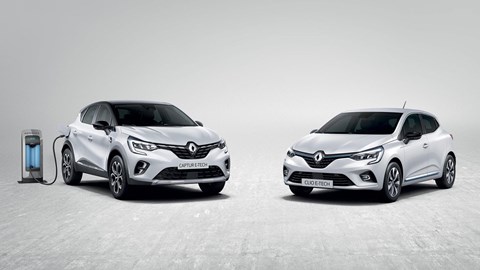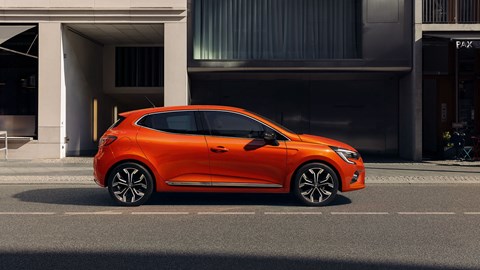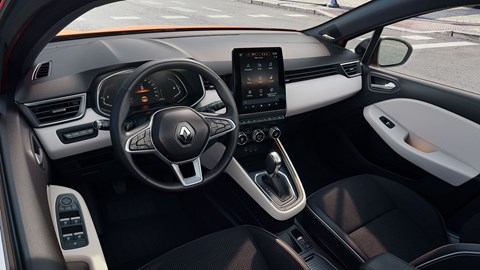► Fifth-generation Renault Clio
► New Clio E-Tech hybrid revealed
► Clever tech for petrol-electric mini
Renault Clio E-Tech is the name for the new petrol-electric hybrid unveiled at the 2020 Brussels Motor Show. It’s one of a dozen electrified vehicles including plug-in versions of the Captur and Megane due before 2022. The Clio is what you’d consider a conventional hybrid (one without a plug socket) and essentially exists for customers looking an eco-concious small car with good efficiency, that isn’t a diesel.
What about the Zoe? Well, Renault told us it couldn’t build a diesel-range aping electric car for less than £30,000, and with the price of diesel going up and batteries going down, the stars aligned for a hybrid Clio.
The E-Tech system uses a 1.6-litre, four-cylinder naturally aspirated petrol engine, originally developed by Nissan and found in the Dacia Duster but with some significant reworking – including hybrid specific injection and camshaft timing, plus a cooled EGR system.

It was chosen specifically for its low-down torque – the hybrid system could work with a turbo, but it’s not actually required in order to provide the performance required. Expect 138bhp and 50-75mph in 6.9 seconds, according to Renault.
Of course not all of that power comes from the internal combustion engine – you also get a 36kW electric motor and a second 15kW motor that is used largely for brake regeneration and for starting the engine up. And powering the gearbox.
See the new Renault hybrid system at the 2020 Geneva motor show.
Wait, what?
Might be worth getting a big tea before diving into this, because it’s going to get a bit complicated. There’s no continuously variable transmission (CVT) here like you often get in a hybrid car – it wouldn’t fit in the tightly packed engine bay. Neither, say Renault’s engineers, would a clutch.
So what you have instead is a multi-mode, clutchless, dog ‘box. Like an F1 car. In fact no production road car has used something like this before and unsurprisingly it’s protected by more than 150 patents. It also has no auxiliary belts, with tiny electric motors for things like the water and oil pumps.

It’s actually two gearboxes in one with unusually two ratios for the electric drivetrain (all electric cars except only the Porsche Taycan have just one) and four for the internal combustion engine, and neutral gears for both.
What that means is that the Clio always pulls away in full EV mode with no thermal assistance (up to 38mph) and can disconnect the electric drivetrain for faster motorway driving. Helping to make these changes seamless and rev-match the gears (no clutch, remember) is the smaller electric motor. Which is also an alternator and starter motor.
Wow…
It’s quite a piece of engineering – the whole system weighs about 10 kilograms more than a dCi 115 engine, while putting out less than 100g/km of CO2. Plus, because the compact 1.2kWh battery is tucked between the rear wheels, you get the same 300-litre boot and spare wheel as the standard Clio, albeit with a smaller 38-litre fuel tank.
We’ve driven it but can’t tell you what it’s like just yet… Sorry. You’ll just have to make do with some more numbers – Renault says high battery charging efficiency and capacity means 80% of time spent on city roads is in all-electric mode, for a fuel save of up to 40%. Stay tuned for our Renault Clio E-Tech review coming up in a few weeks’ time.
Read on for the full story on the regular Clio range – live from its 2019 world debut

Renault Clio hatchback: what’s new for 2020
The new Renault Clio was priced from £14,295 when UK sales began in October 2019 – and that’s a useful chunk below the sector staples, Ford’s Fiesta and Vauxhall’s new Corsa. Four trim levels are available: Play, Iconic, S-Edition and the sportier RS Line. Every model comes with:
- Full LED headlamps
- Air-conditioning
- Cruise control and speed limiter
- DAB radio
- Lane departure warning, autonomous emergency braking and traffic sign recognition
- Electric front windows
- Driver’s seat height adjustment
- 2-inch multimedia screen features
Renault’s exterior designers have been erred on the side of caution, tightening and tweaking rather than starting from scratch. There is more wholsale change inside the new 2020 Renault Clio.
What’s new: the small things
While the rough shape of the new Renault is similar, fresh details set it apart from its predecessor. The new car’s ‘double pupil’ front lights are more aggressive, use solely LEDs, and feature the same C-shaped design as seen the Clio’s larger Megane sibling.
Other small changes make the car feel more premium too; new bonnet surfacing adds detail where there was none before, and a crease mirrors the rear quarter light. Along the side of the car, a pronounced groove starts behind the front-wheel wheelarch, and turns into a crease. Like we said, small things.

At the rear, the Clio keeps same the proportions as before – helping to maintain the supermini’s identity – but Renault has injected detail and a little more aggressiveness into the rear light area.
The new design, with its tapered roof, also has the added effect of improving the new Clio’s aerodynamic performance; at 0.64cda – something Renault claims is best-in-class.
The details are small, but the net result is a more premium feel, something we know Renault has already aiming for with the interior.

Under the skin
The Clio has undergone significant engineering overhaul under those redesigned panels. Renault says over 400 sections of this car have been improved – from the door cuts, to the fit and finish of the bumpers and the wheel gaps. Panel gaps have shrunk too, to give the new Clio a more solid feel, open the doors and you’ll find double-seals for better interior isolation.
Renault says order books for the new Clio will open in September 2019.
New Renault Clio: interior
So here it is – well the inside of it anyway – the brand new Renault Clio. It’s a huge car for Renault; 275,000 were sold in its first year on sale of 2013 and numbers have climbed ever since – culminating in a huge 365,000 units purchased last year – it’s second only to the VW Golf in the European market.
So, how does Renault keep that graph going up, and what direction has it taken with its all-new breadwinner? Here’s the first part of our look at the all-new, fifth-generation Clio.
It’s the big news on the Renault stand at this spring’s Geneva motor show.

Renault Clio: a tech pioneer
We’ll see the exterior of the car later this week, but for Renault – and increasingly the rest of the supermini B-segment as a whole – interior tech is hugely important. Those target younger buyers want connectivity and they want it now.
More than 80% of last-generation Clios sold were specced with the larger seven-inch touchscreen, so from the very beginning, the new fifth-gen Clio was designed with tech at the forefront, Paris claims.

Interior-wise, that means a bold, touch-led interface, bristling with technology under the surface. The new Clio features evolved assistance systems that pave the way towards driverless tech and a more connected infotainment system, too. Look under the metal, and you’ll find a new, optional hybrid powertrain, too.
What is a hybrid car? CAR’s guide to PHEVs, plug-ins and more
Same ideas, new execution
But while the fifth-generation Clio may look new, Renault is keen to convince us it’s more of a heavily repolished ‘Greatest Hits’ than a total departure in philosophy. ‘Clio 5 incorporates the best aspects of the previous generations,’ Laurens van den Acker, Renault’s corporate design director tells CAR. ‘The spaciousness of Clio 2, gen 1’s tech from an upper segment, and the performance of the third gen. And, it keeps the passionate, emotional, sensual dynamic style of gen 4.’
‘Clio 5 starts off a new cycle for Renault. When you have found your soul, stay constant to be a strong brand. Once in a while you have to change to stay relevant, otherwise you become obsolete.’

A design team was assembled to get the rough floating-console concept and look for the interior, and after that it was about crunching down on key aspects of the new cabin. The steering wheel was made lighter and more compact for a sportier feel, while button quality was increased for a more premium experience. When you’ve got the likes of the VW Polo to go up against, every little helps.
Tidying up the screens
Other areas were tweaked too, with the instrument cluster being a key area to fix. ‘The cluster was rich on decoration, not so rich in information,’ van den Acker admits of the previous gen. ‘The [new] cluster had to be extremely visible, with simple access to multiple modes, navigation, classic, sports, eco, more zen, minimalistic – and easier on the eye.’
The infotainment system now plays a key role, with the air vents shifted to make room for the new 9.3-inch, biggest-in-segment touchscreen. It’s more smartphone-like in quality, complete with anti-reflection coating for those rare sunny days. And the brightness and contrast have both been improved, too.

Android Auto and Apple Carplay both make an appearance, though Renault hopes its native UI is good enough to dissuade you from craving them.
What about the seats and fabric in the new Renault Clio?
While tech is the main factor, a need for better ergonomics and spaciousness have led Renault to revise the Clio’s seats, giving passengers more support both underneath and by their sides. They’re easier to adjust, and the shoulders are rounder – so those in the rear have a less cramped view out.
General fit and finish has been rethought, with Renault saying the amount of ‘soft-touch’ areas in the car is drastically improved – especially as you go up the range. ‘With Clio 4, the hard plastics were in your face,’ admits van den Acker. Now he says, ‘what’s soft is close [to the occupants], what’s impacted is far away and hidden.’
We’ll update this article when we know more about the new Renault Clio’s interior and exterior.
Read all our Renault reviews